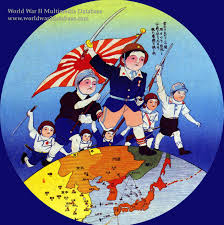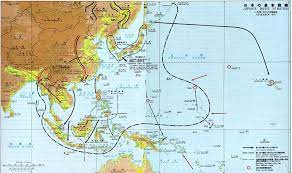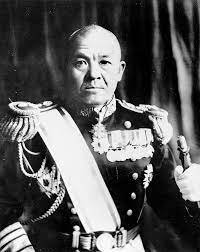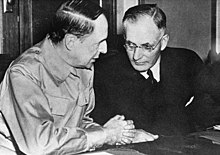The Japanese threat to Australia
Japanese militarism
First, we examines Japanese militarism in the context of Japan’s recent history, focusing on its social and economic developments and the role of traditional thinking. After World War I, two distinct lines of development emerged: economic progress toward big capitalism and a national shift toward fascism as authoritarian ultranationalism, rejecting communism and basic human rights.
Economic difficulties, the rise of extreme nationalist groups, and the moderate attitude of Japanese politicians gave rise to these extremists, including military leaders, who sought to purge the political atmosphere of East Asia. The occupation of Manchuria in 1931 was one consequence of this militaristic ideology.

As Japan’s sphere of influence expanded, differences between military power and administrators of big business regarding political policies became apparent. Militarism grew as a powerful force determining foreign policy, leading to Japan’s commitment to the principle of “Asia for the Asians, but under Japanese leadership.”
Within the Japan’s political system, the constitutional monarchy and parliament had limited influence compared to the advisors to the throne. With both the military and big business holding significant power and influence, Japanese politics were largely determined by these ruling entities. The Japanese government’s compromise-driven approach and accommodation of the dominant groups often resulted in a lack of a strong and purposeful policy, contributing to the rise of militarism.
Parliamentary impotence and the limited development of parliamentarianism in Japan facilitated the rise and maintenance of Japanese imperialism. The Crown held the rights to conclude treaties, declare and end wars, and foreign policy was kept entirely out of parliamentary control. Religion, tradition, and education played significant roles in shaping the Japanese sense of state without placing co-responsibility on the citizens’ shoulders as seen in Western democracies.
This led to the formation of the Imperial General Headquarters in 1937, which became the highest military advisory body directly influencing the imperial cabinet, bypassing parliamentary criticism. An open conflict between industrial capitalism and the army in 1936 further intensified militaristic tendencies, leading to the attack on northern China in 1937 and eventually culminating in the raid on Pearl Harbor in 1941.
Japanese objectives in WWII

Japanese foreign policy aimed at achieving complete dominance over Asia and undisputed authority over the western part of the Pacific. The principle of “Asia for the Asians, led by Japan” emerged as the basis for this policy, rooted in the belief that the Japanese, as descendants of the Sun God, were the natural leaders of Asia and the world.
To realise their objectives, Japan needed to gain control of strategically important areas such as the Philippines and the rich natural resources of the Dutch East Indies and Malacca. In 1941, Japan made the decision to pursue these goals through military force. Japanese military strategists assessed the following conditions as their starting positions:
a) The threat of Russia on the Manchurian flank was neutralised by Germany’s victories over Russia, leading to the collapse of the Russian republic.
b) England was on the defensive and primarily capable of defending its island kingdom.
c) The Allied forces, including the United States, in the Pacific were deemed insufficient to withstand the well-trained Japanese forces. Japanese military planners estimated that the occupation of various territories such as Burma, Sumatra, Java, Dutch New Guinea, and others would take place within three to four months.
d) The Japanese assumed that the United States, due to its aid to England and the loss of Pearl Harbor as a stronghold in the Pacific, would not be able to launch offensive action for 18 to 24 months. During this time, Japan aimed to consolidate its conquered and occupied territories, strengthen its borders, and support its principal naval force, the Carrier Strike Force, stationed on the island of Truk, which housed a large naval base.
e) The Japanese believed that the determination to defend the occupied territory, coupled with the utilisation of its raw materials to strengthen industrial and military capabilities, could undermine the will of the United States.
f) The Japanese anticipated that the mentality of American democracy would prevent an all-out offensive action, considering the expected losses and the fanatical opposition of the Japanese armed forces. This perspective possibly influenced a compromise regarding the occupation of Pacific countries and islands.
The choice between Australia and the Middle East
Japan faced the choice of expanding its conquests either towards Australia or the Middle East. Initially, Japanese strategic offensive thinking focused on Southeast Asia, with Australia being vaguely considered. However, after the American air raid on Tokyo by Lieutenant Colonel ‘Jimmy’ Doolittle in April 1942, which caused a shock to the Japanese people and accelerated their offensives, the question of expanding the set borders arose.
Admiral Isoroku Yamamoto and his Chief of Staff Matomi Ugaki evaluated three possibilities:
- attacking India and Ceylon,
- attacking Australia, or
- attacking Hawaii.
The preference was given to the attack on Hawaii due to several reasons. Time worked against Japan as the American war potential was growing, and it was crucial to launch an offensive quickly to avoid counterattacks. If England was defeated by Germany, the British fleet would likely join the American fleet, overpowering the Japanese. Thus, defeating the American fleet as soon as possible was deemed necessary. The loss of the American Pacific fleet, the occupation of the Hawaiian Archipelago, and the capture of Pearl Harbor would deal a significant blow to the Americans. The Japanese believed they had a good chance of success in a decisive battle near Hawaii, considering the favourable ratio of aircraft carriers and the superiority of their battleships. The only concern was the fortified island of Midway, acting as a guard post.

Simultaneously, Vice Admiral Chuichi Nagumo explored the possibility of attacking the British fleet in the Indian Ocean and occupying Ceylon, known as Plan West. This plan aimed to control the Indian Ocean, protect occupied territories, and join forces with Germany in the Middle East. However, the Army vetoed this plan as it was deemed infeasible. The Japanese Army was more focused on Russia and awaited the German attack in the Caucasus to launch an attack on Russia’s back while advancing through British India into the Middle East.
In addition to these plans, Captain Sadatoshi Tomiako of the Navy staff proposed an attack on Australia to cut off supply lines and prevent it from becoming a springboard for Allied counterattacks. However, the Army rejected this plan, citing the need for ten divisions, which they could not provide. The Army prioritised an advance through British India into the Middle East, aligning with the overall strategy of dividing the world with Germany. Thus, the decision was made not to implement General Tomoyuki Yamashita’s plan to conquer Australia.
The Japanese consolidation plan
As a result of conflicting plans and considerations, Japan adopted a less ambitious consolidation plan. The objective was to isolate Australia by extending control over strategic locations such as New Guinea, the Solomon Islands, New Caledonia, and the Fiji Islands. This plan aimed to create a better defence in depth.
Admiral Yamamoto proposed a naval operation in the Indian Ocean without army support to deal a devastating blow to the British fleet. This operation would facilitate further operations against Ceylon, British India, or Australia. On March 26, 1942, a fleet consisting of five aircraft carriers, three battleships, six cruisers, twenty destroyers, and support ships was dispatched under Admiral Nagumo’s command. They attacked Colombo in Ceylon on April 5 and the naval base at Trincomalee on April 9, causing significant damage to coastal and port installations and sinking several ships and aircraft.
Another group of Japanese surface ships, under the command of Vice Admiral Ozawa, conducted operations in the Indian Ocean, sinking cargo ships off the coast of Madras and conducting bombing raids on mainland British India before returning to the Singapore base.
At the highest military level, the following actions were approved: the attack and occupation of the Solomon Islands and Port Moresby in southern New Guinea, followed by potential attacks and occupations of New Caledonia, the Fiji archipelago, and Samoa. The capture of Midway Island and a temporary occupation of the Aleutian Islands in the Bering Sea were also planned. These actions aimed to cut off the communication line between America and Australia, reduce the military threat from Alaska, and render the staging area of the U.S. Fleet and other Pacific forces inoperable west of the Hawaiian Islands.
Australia cornered
The Japanese advanced rapidly in the Pacific, occupying strategic locations such as the southern part of the Solomon Islands, Rabaul, Gasmata, and Kavieng. By occupying the Gilbert Islands and establishing positions in New Guinea, they directly threatened Australia and the sea lanes. Allied commanders anticipated that Darwin and Port Moresby would be the next targets of the Japanese.
Darwin’s occupation would provide a base for future offensives against Australia, while an attack on Port Moresby could flank the east coast of Australia and disrupt sea and air routes. Intelligence reports estimated that the Japanese had nine divisions available for these operations.
The Allied forces, primarily located in mainland Australia, were inadequate and weakened due to late rearmament and the consequences of previous campaigns. The Australians’ frontline forces consisted of three divisions, with the 7th Australian Division expected to return to Australia by the end of March 1942. The Royal Australian Air Force (RAAF) and Royal Australian Navy (RAN) also faced limitations in terms of aircraft, trained crews, and naval vessels.
The United States planned to reinforce Australia with bomber and fighter groups, as well as the arrival of the 42nd Division in April. However, the combined forces were insufficient to defend a country the size of the United States. Additionally, transportation difficulties, including varying gauges and vulnerable coastal roads, hindered concentration of forces.
Amidst these challenges, General MacArthur emerged as a capable leader to confront the situation. His arrival provided hope for effectively dealing with the Japanese threat. See also: Americans enter the war in the South-West Pacific
‘Europe first’ – a threat to the Pacific
The Allied plan known as “Europe first” posed a threat to Australia’s defence. Following the attack on Pearl Harbor, U.S. President Roosevelt and British Prime Minister Churchill met in Washington and made two important decisions. The first was to pool their military and economic resources under the Combined Chief of Staff (CCOS), which proved vital for achieving victory.
However, the second decision had unfavourable implications for Australia. It was agreed that if the United States were involved in the war against both Germany and Japan, the main focus of Allied cooperation would be Germany. This raised concerns among the Australians, who observed the intensity of the Japanese attack and were uncertain if the Americans would still prioritise Germany.
The British, General Marshall presented a memorandum stating that despite Japan’s entry into the war, Germany remained the primary enemy, and her defeat was key to victory. This position formed the basis of the Anglo-American strategy. However, it meant that resources, including ships and materials, were primarily allocated for the European theatre of combat, leaving Australia in need of shipping space for defence purposes.
The Australian government perceived an imminent threat of Japanese forces invading the Australian mainland. Despite Australia being considered the main base of operations in the region after the fall of Singapore, Japanese naval superiority posed a significant problem for defence. It was estimated that the Allies could not provide adequate reinforcement in the Pacific until after May 1942.

In response, the Australian government decided to withdraw its land forces from other theatres, such as North Africa, and redeploy them to Australia. This move aimed to prioritise defence in the Pacific. Churchill received a clear message from Australian Prime Minister John Curtin, indicating their government’s vision for their forces to operate in the Pacific.
The Allied plan of “Europe first” posed challenges for Australia’s defence, as resources were predominantly allocated to the European theatre of combat. However, the Australian government sought to shift their focus and prioritise the defence of their own region against the imminent threat of Japanese forces.
Australia on the defensive
Australia found itself on the defensive as the situation in the Pacific deteriorated. Australian Prime Minister Curtin requested the return of the 6th and 7th divisions to defend Australia, but British General Wavell suggested sending them to Burma instead. Churchill and Roosevelt also emphasised the importance of defending Burma as a strategic priority. However, the Australian government insisted on the return of their forces to face the Japanese threat in the Pacific.
The fall of the Philippines allowed the Japanese military to reorganise and plan new offensives. General MacArthur’s headquarters anticipated Japanese advances towards the mainland. MacArthur highlighted the danger posed by the Japanese regrouping in Malaya and the Dutch East Indies, suggesting potential attacks on New Guinea and the connection between Australia and America.
MacArthur stressed the need for adequate security measures in Australia and the Pacific, including a strong defence and a threat of offensive action. He warned that without sufficient defences, the vast area to be defended and poor communication facilities would give the enemy a significant advantage. MacArthur emphasised the urgency of building up defences before the enemy applied pressure.
The Japanese faced strategic challenges after their initial successes in Southeast Asia. They realised they were in a different type of war and had failed to destroy the American aircraft carriers, their primary objective. Japan had to determine how to maintain their victories and bring the war to an end while dealing with limited resources. Their offensive position was unsustainable, and they lacked a definitive plan for the next steps.
The situation was grave for Australia, as Japan had achieved significant victories, and the Allies were recovering from their initial losses. Australia saw the defence of their homeland as a primary obligation and sought to repel any Japanese attack. Meanwhile, the Japanese faced strategic dilemmas and challenges in maintaining their successes.
Source, including pictures: De Militaire Luchtvaart van het KNIL in de jaren 1942-1945
